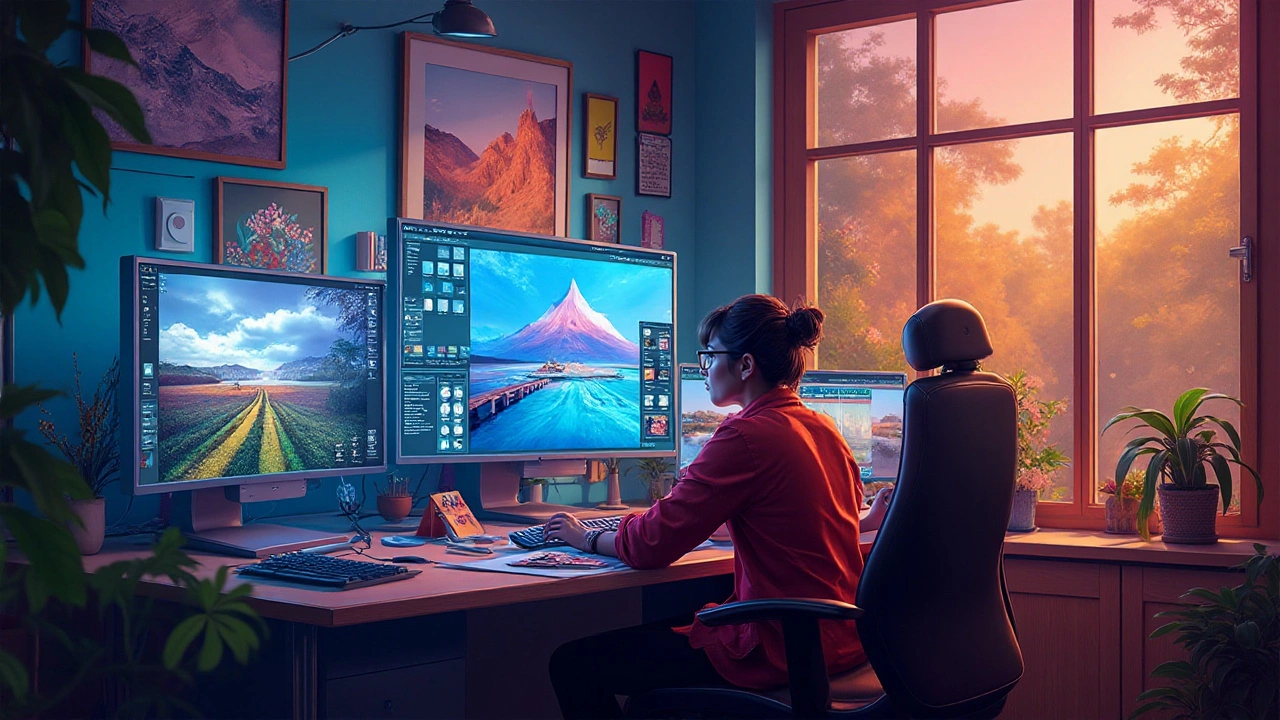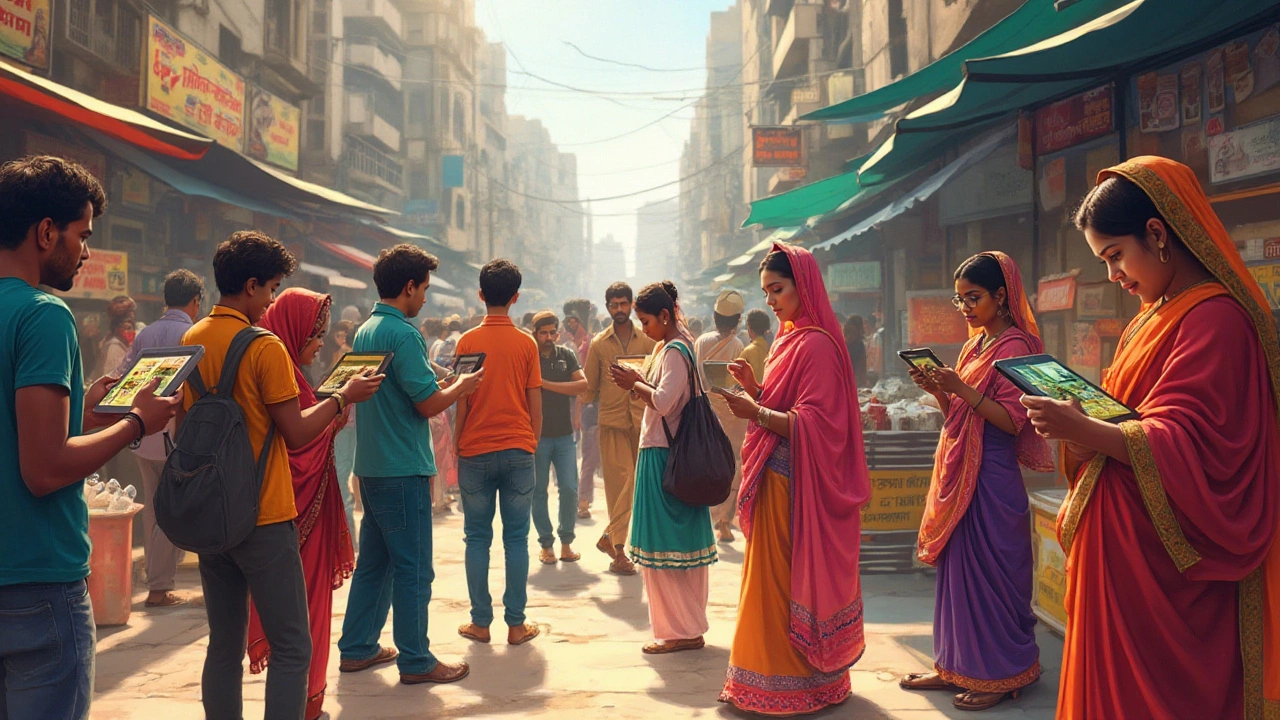Top Online Photo Editing Sites for Creatives in 2025
 Jan, 25 2025
Jan, 25 2025
In the age where capturing moments has become second nature, the role of photo editing has never been more crucial. Whether you're a professional photographer or someone who simply loves to enhance your daily snapshots, finding the perfect online photo editing site can change the way you see your work. With so many options out there, how do you decide which one suits you best?
As we dive into 2025, technology continues to evolve, offering us some fantastic platforms that cater to different editing needs. Imagine having all the tools you need right at your fingertips without the necessity of hefty software downloads. This is what online photo editing sites promise, and in this article, we will peel back the layers to reveal some of the top contenders in this digital space.
- Popular Online Photo Editors
- Features to Look for in a Photo Editor
- Tips for Choosing the Right Editor
- Making the Most of Online Editing Tools
Popular Online Photo Editors
Choosing the right online photo editing site can feel like picking the perfect camera lens—each choice provides different features and enhancements. Among the popular names in photo editing apps in 2025, Adobe Express, Fotor, and Pixlr are leading the pack in terms of flexibility and user experience. Each of these platforms offers a unique blend of tools that cater to both novice and experienced users. Adobe Express, known for its connection to Adobe's storied ecosystem, offers powerful touch-up capabilities that ensure your photos reflect your vision. At the same time, Fotor is loved for its simplicity and efficiency, making quick edits a breeze even for the less tech-savvy.
Pixlr, meanwhile, is a favorite due to its sophisticated interface which somehow remains intuitive and accessible. This application is cloud-based, providing users with the power of editing from virtually anywhere with an internet connection. Many swear by its ability to rival desktop programs in terms of features without the burdensome installation process. As someone aptly put it, Pixlr is "like having Photoshop in your pocket," signifying its potential to deliver professional results right from the browser.
"Online photo editors have radically changed how we manage our digital resources," states Michael Franco, a photography expert, "What was once restricted to bulky software is now at our fingertips on-the-go."
Statistics indicate that more than 50% of amateur photographers in 2024 used web-based platforms over traditional software, underscoring how the trend is shifting towards flexibility and ease of access. This reflects a growing preference for platforms that amalgamate robust editing tools with the convenience of cloud storage and cross-device compatibility.
In the world of online photo editing, the focus is not just on basic filters or cropping tools but on fostering creativity without being bogged down by technical hurdles. These platforms understand the audience's need for efficiency combined with artistic control. With features like AI-driven enhancements and batch processing becoming more common, these tools offer capabilities previously limited to professionals. Plus, the collaborative aspects of some online editors allow multiple users to work on the same project seamlessly, adding a communal aspect to the editing process often unseen in offline software.
It's also worth exploring how online editors rival their offline counterparts by integrating directly with social media platforms, permitting direct uploads to sites like Instagram or Facebook. This instantaneous connectivity appeals greatly to the 'edit-share' culture prevalent among today's digital audiences.
Finally, beyond simple user interfaces and beginner-friendliness, advanced users often tap into their inner artist through complex tweaks and modifications available on platforms like BeFunky or Photopea. These editors mirror many features found in high-end software but with a straightforward approach that encourages experimentation. Understanding the nuances of these platforms and recognizing what you're looking for in a tool is crucial in selecting the editor that matches your specific needs.

Features to Look for in a Photo Editor
Embarking on the journey to find the best online photo editing tool means knowing exactly what kind of features will heighten your creativity and efficiency. The first aspect to consider is the user interface. A clean, intuitive design is not just a convenience but a catalyst for faster and more inspired editing. If you're constantly stumbling over complex layouts, the software's power becomes moot. Instead, look for editors that emphasize a straightforward but sophisticated arrangement of tools.
Another critical element is the availability of creative filters and effects. These preset modifications offer a quick fix for elevating photos from mundane to magnificent. Many contemporary editors bolster their utility by integrating AI-powered features that intuitively suggest edits or even complete them based on input photos. The stalwart presence of these modern twists can provide you with a set-up that's not only innovative but also future-proof.
One of the often-overlooked facets in the realm of photo editing apps is collaboration capabilities. In professional settings, being able to seamlessly share and receive real-time feedback on edits can streamline workflows significantly. Platforms offering cloud storage or collaborative tools can save users both time and headaches. These editors level the playing field between teams, ensuring that everyone is rowing in the same direction.
Customization also plays a pivotal role. While presets are fantastic for speed, having detailed manual control can spell the difference between good and great. Prospective users should explore how deeply photo editors allow adjustments on parameters like exposure, saturation, and sharpness. Tailored control over these elements means the artist can truly render their vision without compromise.
Performance is key. Comparing how swiftly an editor can handle large files or process complex edits might seem secondary, but this sets apart the efficient tools from the laggards. A good photo editing site must also handle a multitude of formats, ensuring photographers aren't caught out by troublesome image incompatibilities.
According to Coil, "Intuitive design, collaborative features, and performance are becoming essential for the future of editing apps—the technologies that reduce frustration and enhance creativity will always win."Finally, take note of advanced tools that cater to more than just novices. From dodging and burning features to lens correction abilities and gradients, such offerings propel an editor from basic to professional. It's these fine details—when provided alongside robust tutorials and support—that create an empowered editing environment for any user.
Interestingly, a survey conducted by the Image Editing Association found that 68% of professional editors emphasized software flexibility as their top priority, while surprisingly, less than 30% prioritized a massive selection of filters.

Tips for Choosing the Right Editor
Choosing the right online photo editing tool is akin to selecting the perfect pair of shoes; it must feel just right and serve its intended purpose. When you venture into the realm of photo editing apps, clarity on your requirements is essential. Are you aiming for quick enhancements, or are you seeking more intricate control over your photographs? Understanding your goals will significantly narrow down the options. Start by evaluating the interface. A user-friendly interface can greatly enhance your creative process, making complex tools more accessible and less daunting. Imagine a painter with an intuitive canvas; that’s what a good editor should be.
The feature set is another crucial component. While some editors offer basic adjustment features like cropping and color balancing, others come packed with advanced tools such as AI-powered enhancements and batch processing. Consider what specific features align with your editing needs. Do you need customizable filters? Or perhaps you require layers and masks for more detailed work? Make a list of must-have features before committing to a platform. It might also be worth your while to test the waters with sites that offer free trials or have a free tier, allowing you to familiarize yourself with what’s available without financial commitment.
Compatibility is key, especially if you're toggling between multiple devices. Ensure the photo editing site you choose integrates seamlessly with your current software. Responsiveness across different platforms, whether you're on a computer or mobile device, can save you ample amounts of frustration in the long run. With the growing trend of image editing tools offering cloud storage, saving your work across devices has become more streamlined, providing ease of access no matter where you are working from.
"The best camera is the one that's with you," said Chase Jarvis. The same goes for editing tools; the best editor is the one you can seamlessly access and use effectively."
Last but not least, consider the pricing model. While some platforms are subscription-based, others might have a one-time purchase fee. Additionally, some apps offer in-app purchases, which can slowly add up over time. Be sure to assess the long-term costs and compare them against the benefits you receive. Also, look out for any hidden costs such as premium features not included in the basic package. Often, it’s a delicate balance between cost and functionality, and knowing your budget and how far it can stretch is an important part of the decision-making process.
If you often work collaboratively, keep an eye out for features that facilitate sharing and collaboration. Editing tools with cloud-based project sharing capabilities are invaluable for group projects or when you need feedback from clients or partners. By selecting a site that supports real-time changes and edits by multiple users, you can significantly enhance productivity and streamline the workflow.

Making the Most of Online Editing Tools
The digital revolution has put powerful image editing tools within reach of virtually everyone, allowing for creativity and artistry to flourish without the expense and complexity of traditional software. Yet, with great power comes the challenge of knowing how to leverage these tools to their full potential. Firstly, it's essential to acquaint yourself with the interface of whatever platform you're using. Many popular editors like Canva and Pixlr offer intuitive user interfaces, but they often come packed with features that can be a bit overwhelming for beginners.
To make the most of these tools, start by setting clear goals for your editing sessions. Are you trying to achieve a vintage look, or perhaps enhance colors to make them pop? With a strong goal in mind, you can focus on the tools that will help achieve your desired outcome. Moreover, don't overlook the value of tutorials. Many platforms include built-in tutorials or links to community-driven how-to guides that can drastically shorten your learning curve. Websites like Adobe Spark even offer interactive sessions that let you experiment as you learn.
Exploring Advanced Features
Once you've mastered the basics, it's time to dive into the advanced features these platforms offer. Elements like layers and masks, which are standard in professional-grade software, can be found in many online editors too. Understanding and utilizing these advanced features can significantly enhance your editing capabilities. Learning to work with layers, for example, can provide more control over individual parts of your image, while masks can allow for precise adjustments in specific areas without affecting the entire photo. A great tip is to experiment with different styles and techniques. Sometimes, surprising results emerge from simply playing around and pushing boundaries.
"The best photo editors today are not about the tools themselves, but about what you do with them and how you push the limits of your creativity," quotes Deborah Haberkorn, an experienced digital photographer.
Leveraging Community Insights
Don't forget about the vibrant communities that often surround powerful online photo editing apps. Engaging with forums, social media groups, or even attending online webinars can expose you to a wide array of creative techniques and solutions others have discovered. Sites like Reddit and Quora can offer valuable peer-to-peer advice that can make your learning journey smoother and more rewarding.
Data and Metrics
Some editing sites include analytics to help track engagement metrics, especially if you're creating photographs for social media or professional portfolios. Understanding these insights can guide you in refining your editing techniques to better capture your audience's attention.
| Platform | User Rating | Unique Feature |
|---|---|---|
| Canva | 4.5/5 | Drag-and-Drop Simplicity |
| Pixlr | 4.2/5 | Advanced Layering Tools |
| Fotor | 4.3/5 | HDR and Batch Processing |
In your journey to master these powerful online photo editing platforms, patience and persistence are your greatest allies. The more you engage with the tools and the community, the more skills you'll gain, eventually leading you to create visual narratives that are uniquely yours.